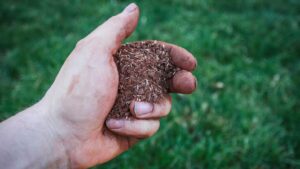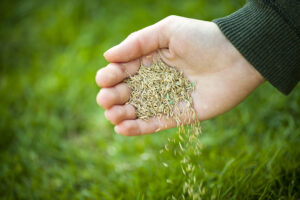Table of Contents
 Do you plan to oversee your Bermuda lawn this season? If so, you’re in for a bit of a challenge. Overseeding is common for gardeners, but it’s not without risks. Overseeding is a great way to rejuvenate your lawn and get it back to the lush green look you were hoping for.
Do you plan to oversee your Bermuda lawn this season? If so, you’re in for a bit of a challenge. Overseeding is common for gardeners, but it’s not without risks. Overseeding is a great way to rejuvenate your lawn and get it back to the lush green look you were hoping for.
Planting too much vegetation in one area can cause problems for your plants and soil. Overseeding can be a great way to increase the size and density of your turf, but it can also lead to issues like turf burn and overgrowth.
In this article, we’ll outline the risks and benefits of overseeding with Bermuda and give tips on minimizing those risks.
Overseeding With Bermuda – You Must Know
You may wonder what that means if you’re thinking about overseeding your lawn. And if you’ve never done it before, you might wonder whether it’s safe. The short answer is yes: overseeding can be a great way to get a thicker, healthier lawn.
You’re oversowing when you add new grass seed to an existing lawn. It’s typically done when spring arrives and temperatures start warming up, but some people also choose to do it earlier in the year.
The process involves raking up dead or dying grass and spreading new seeds evenly across the soil surface.
Some people think that overseeding will help prevent weeds from taking over their lawns during the summer when they’re more likely to grow quickly than grass after being dormant all winter. But this isn’t entirely true — unless you want weeds growing everywhere on your lawn!
Note: Overseeding only works if there are bare spots on your lawn where weeds can take over in the first place.
Best Time to Overseed

However, it cannot be easy to know when to overseed Bermuda grass.
If you do it too early, you’ll wait for weeks or months before the new growth appears. Don’t wait too long to plant the seedlings, or you may kill them before winter sets in.
It’s best to overseed Bermuda grass in late summer or early fall when it reaches full maturity. This gives the new seeds ample time to germinate before cold weather hits and kills them off.
When you plant the seeds, you’ll want to ensure that your soil is fertile enough to support healthy growth. A lot of nutrients get depleted over time, so if your yard hasn’t been fertilized recently. Add a little fertilizer before you sow Bermuda grass seed.
Method of Overseeding

What You’ll Need:
- Bermuda Grass Seed
- Spreader (optional)
Step 1: Mow your grass short (3/4-inch). This will make it easier for the new seedlings to grow through the old grass blades. Leave clippings on the lawn instead of bagging them up, so they’ll provide nutrients for your fresh grass as it grows.
Step 2: Before spreading seed over your hardscapes, use a power rake or rotary tiller to break up clumps or compacted areas. This will help prevent disease problems later on if you do end up with some bare spots later on due to poor germination rates on your part (or just bad luck).
Step 3: Mix up a batch of seed and fertilizer to have a balanced ratio (4:1:1) of nitrogen, phosphorus, and potassium. Apply this mixture evenly over the area you want to seed, then water it as needed. Once everything has been watered in, roll over the area with a lawn roller to pack down the soil and help prevent weeds from sprouting up prematurely.
Note: As for where exactly to place your new seed, be sure not to be overseed too close to established plants or trees as they will compete for nutrients and sunlight with them. Instead, try spreading the new seeds in rows about six inches apart throughout your yard, so they have plenty of room to grow without getting trampled on by foot traffic or pets.
How long should you wait after seeding?
Well, it depends on the amount of grass seed you’re using and how much you want to overseed. Here are some guidelines:
You can help your lawn grow thicker by seeding a small amount of seed. If you’re adding a little bit of extra seed, say 50 pounds in total for an entire yard, then wait about two weeks before mowing. This will give the seeds time to germinate and start growing.
You can help your lawn grow thicker by seeding a large amount of seed.
If you’re using more than 50 pounds of Bermuda grass seed, wait until all of the seeds have germinated before mowing. This can take anywhere from three to six weeks, depending on how warm it is outside and how often you water your yard (or whether or not it rains).
Grass Seeds to Overseed With

If you want to overseed your existing Bermuda lawn with more Bermuda grass seed, here are some tips:
- Choose a time when the ground is moist but not saturated. This will reduce compaction issues and give your new seedlings a better chance of survival.
- Use high-quality seed when overseeding your existing turfgrass with another variety of Bermuda grass seed. You’ll get better results from higher-quality, disease-resistant seeds rather than cheap bagged varieties at the hardware store or big box store that may contain weed seeds or other undesirable contaminants in addition to unwanted types of grasses or weeds that could compete with your new plants as they take root in your existing turfgrass.
- Blend of Four Parts: If you want to overseed with Bermuda grass, we recommend using a blend of four parts fine-textured fescues (such as Tall Fescue and Chewings Fescue) and one part Kentucky Bluegrass.
- Two Parts of Perennial: You can also use two parts Perennial Ryegrass and one part Tall Fescue.
Next, spread the seed evenly over the area where you want to seed. Use a roller or a hand seeder with wheels to cover the surface of the soil.
Bermuda Grass Mix With other Grass Seeds
You can over-seed your Bermuda grass with other varieties, such as fescue or Kentucky bluegrass. The best type of grass seed depends on the Bermuda grass percentage on your lawn.
The common types of grass seeds that are used for overseeding are:
Annual and perennial ryegrass
Fescue (such as Kentucky bluegrass)
Last Words
The secret to having a beautiful lawn is proper planning and preparation. With the right products and techniques, you can have a lush backyard.
To get started, read our articles that may help make your green carpet more attractive. Overseeding is removing patches or having a heavy look on your lawn floor. So we have concluded after our research that there is no harm in overseeding. The only thing you need to consider is “Prior Knowledge” of time to overseed and methods to follow. If you like to leave your comments, we positively appreciate you. Thanks for Reading.
